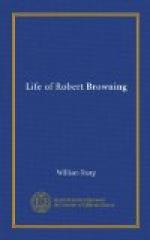CHAPTER III.
The public reception of “Pauline”; criticisms thereupon; Mr. Fox’s notice in the Monthly Repository, and its results; Dante Gabriel Rossetti reads “Pauline” and writes to the author; Browning’s reference to Tennyson’s reading of “Maud” in 1855; Browning frequents literary society; reads at the British Museum; makes the acquaintance of Charles Dickens and “Ion” Talfourd; a volume of poems by Tennyson published simultaneously with “Pauline”; in 1833 he commences his travels; goes to Russia; the sole record of his experiences there to be found in the poem “Ivan Ivanovitch,” published in Dramatic Idyls, 1879; his acquaintance with Mazzini; Browning goes to Italy; visits Asolo, whence he drew hints for “Sordello” and “Pippa Passes”; in 1834 he returns to Camberwell; in autumn of 1834 and winter of 1835 commences “Sordello,” writes “Paracelsus,” and one or two short poems; his love for Venice; a new voice audible in “Johannes Agricola” and “Porphyria”; “Paracelsus,” published in 1835; his own explanation of it; his love of walking in the dark; some of “Paracelsus” and of “Strafford” composed in a wood near Dulwich; concerning “Paracelsus” and Browning’s sympathy with the scientific spirit; description and scope of the poem; quotations therefrom; estimate of the work, and its four lyrics. Page 49.
CHAPTER IV.
Criticisms upon “Paracelsus,” important one written by John Forster; Browning meets Macready at the house of Mr. Fox; personal description of the poet; Macready’s opinion of the poem; Browning spends New Year’s Day, 1836, at the house of the tragedian and meets John Forster; Macready urges him to write a play; his subsequent interview with the tragedian; he plans a drama to be entitled “Narses”; meets Wordsworth and Walter Savage Landor at a supper party, when the young poet is toasted, and Macready again proposes that Browning should write a play, from which arose the idea of “Strafford”; his acquaintance with Wordsworth and Landor; Ms. of “Strafford” accepted; its performance at Covent Garden Theatre on the 26th May 1837; runs for five nights; the author’s comments; the drama issued by Messrs. Longman & Co.; the performance in 1886; estimate of “Strafford”; Browning’s dramas; comparison between the Elizabethan and Victorian dramatic eras; Browning’s soul-depictive faculty; his dramatic method; estimate of his dramas; Landor’s acknowledgment of the dedication to him of “Luria”. Page 73.




